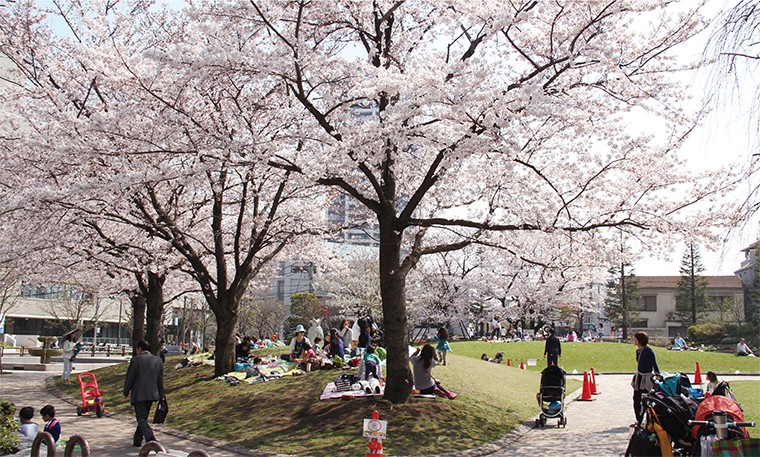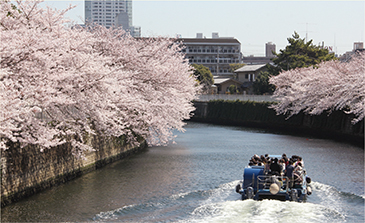
The Many Cherry Blossom Spots in Shinagawa City Shinagawa Chuo Park |
| The arrival of spring each year brings the excitement of waiting for cherry blossoms. The sight of thousands of pink flowers blooming in unison is one of the unique beauties of Japan. In this issue, we introduce famous cherry blossom viewing spots around Shinagawa City. ■ Shinagawa Kumin Park (3-2 Katsushima): The city’s largest general park, includes exercise facilities, a day camping site and Katsushima-no Umi, an artificial pond using seawater. Some 400 cherry trees are in bloom during blossom-viewing season. ■ Shinagawa Chuo Park (in front of the Shinagawa City Office): This well-equipped park includes a fountain, open grassy spaces and playground equipment. In addition to Somei-Yoshino cherry blossoms, the park has four old Gongen-zakura(Edohiganzakura) trees that were donated by local residents. ■ Higashi-Shinagawa Kaijo Park (3-9 Higashi-Shinagawa): Eighty-eight cherry trees are planted here at the mouth of the Meguro River as it flows into the sea. Enjoy a pleasant walk along the canal boardwalk. ■ Shinagawa Hanakaido (2-17 Higashi-Oi area): Local residents came up with idea of planting flowers on the banks of the Katsushima Canal. The result of their efforts is a 2km stretch of flowers. In the spring, you can enjoy the beauty of both canola flowers and cherry blossoms at the same time. ■ Sakura-Shinmichi st. (Minami-Oi, 3–6 ): Sato-zakura trees are planted along both sides of the road for 1km. The opulent elegance of Sato-zakura (double-petaled) provide a charmingly different viewing experience compared with Somei-Yoshino trees. ■ Kamuro Slope (4 Nishi-Gotanda): This slope, located near Fudomae Station, is lined with 1km of cherry trees. Enjoy the pleasures of hanami (cherry blossom viewing) this year close to home. |
| 【The Roots of Hanami and Somei-Yoshino Cherry Trees】 Although there are several theories on the origins of the spring hanami (cherry blossom viewing) tradition in Japan, the practice is said to have started as a ritual offering made to the cherry tree gods to pray for a good harvest. Sometime during the Nara era, hanami transformed into a form of entertainment among the aristocracy for composing poems while admiring plum blossoms. In the Heian era, the practice developed into an appreciation for cherry blossoms. By the Kamakura era, hanami had spread beyond the aristocracy to samurai and merchant class. By the Edo era, it had become a recreational event enjoyed by all.
|
 Copyright (C) 2016 Shinagawa City. All rights reserved. |
